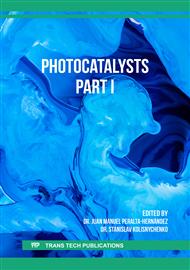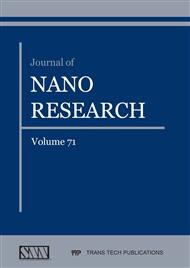[1]
D. Komaraiah, E. Radha, J. Sivakumar, et al, Photoluminescence and photocatalytic activity of spin coated Ag+ doped anatase TiO2 thin films, J. Optical Materials. 108 (2020) 110401.
DOI: 10.1016/j.optmat.2020.110401
Google Scholar
[2]
V.N. Punitha, S. Vijayakumar, B. Sakthivel, et al, Protection of Neuronal cell lines, antimicrobial and Photocatalytic behaviours of eco-friendly TiO2 nanoparticles, J. Journal of Environmental Chemical Engineering. 8 (2020) 104343.
DOI: 10.1016/j.jece.2022.108682
Google Scholar
[3]
X. Li, F. Zhang, B. Zhai, et al, Facile synthesis of porous anatase TiO2 nanomaterials with the assistance of biomass resource for lithium ion batteries with high-rate performance, J. Journal of Physics and Chemistry of Solids. 145 (2020) 109552.
DOI: 10.1016/j.jpcs.2020.109552
Google Scholar
[4]
W. Tao, M. Wang, B. Zhu, et al, In-situ synthesized binder-free flocculent TiO2-x film as anode for lithium-ion batteries, J. Electrochimica Acta. 334 (2019) 135569.
DOI: 10.1016/j.electacta.2019.135569
Google Scholar
[5]
R.R. Maca, D.C. Juárez a, M.C. Rodríguez a, et al, Nanointerface-driven pseudocapacitance tuning of TiO2 nanosheet anodes for high-rate, ultralong-life and enhanced capacity sodium-ion batteries, J. Chemical Engineering Journal. 391 (2020) 123598.
DOI: 10.1016/j.cej.2019.123598
Google Scholar
[6]
J. Singh, K. Sahu, B. Satpati, et al, Facile synthesis, structural, optical and photocatalytic properties of anatase/rutile mixed phase TiO2 ball-like sub-micron structures, J. Optik. 188 (2019) 270-276.
DOI: 10.1016/j.ijleo.2019.05.053
Google Scholar
[7]
L. Wang, Y. Cai, L.Y. Song, et al, High efficient photocatalyst of spherical TiO2 particles synthesized by a sol–gel method modified with glycol, J. Colloids & Surfaces A Physicochemical & Engineering Aspects. 461 (2014) 195-201.
DOI: 10.1016/j.colsurfa.2014.07.050
Google Scholar
[8]
S.T. Rahmat, W.K. Tan, G. Kawamura, et al, Synthesis of rutile TiO2 nanowires by thermal oxidation of titanium in the presence of KOH and their ability to photoreduce Cr(VI) ions, J. Journal of Alloys and Compounds. 812 (2019) 152094.
DOI: 10.1016/j.jallcom.2019.152094
Google Scholar
[9]
Yutang, Kang, et al, Stainless steel mesh supported TiO2 nanowires membrane with ultra-high flux for separation of oil-in-water mixtures and emulsions, J. Surface & Coatings Technology. 375 (2019) 518-526.
DOI: 10.1016/j.surfcoat.2019.07.049
Google Scholar
[10]
N.J. Ismail, M.H.D. Othman, S.A. Bakar, et al, Hydrothermal synthesis of TiO2 nanoflower deposited on bauxite hollow fibre membrane for boosting photocatalysis of bisphenol A, J. Journal of Water Process Engineering. 37 (2020) 101504.
DOI: 10.1016/j.jwpe.2020.101504
Google Scholar
[11]
S. Lu, S. Yang, X. Hu, et al, Fabrication of TiO2 nanoflowers with bronze (TiO2(B))/anatase heterophase junctions for efficient photocatalytic hydrogen production, J. International Journal of Hydrogen Energy. 44 (2019) 24398-24406.
DOI: 10.1016/j.ijhydene.2019.07.212
Google Scholar
[12]
Z.Y. Zhang, Q. Wang, H.Q Xu, et al, TiO2 nanotube arrays with a volume expansion factor greater than 2.0: Evidence against the field-assisted ejection theory, J. Electrochemistry Communications. 114 (2020) 106717.
DOI: 10.1016/j.elecom.2020.106717
Google Scholar
[13]
Y. Wang, C.L. Li, H. Yang, et al, The growth of anti-friction and wear-resistance TiO2 nanotube arrays driven by residual stress, J. Tribology International. 154 (2021) 106736.
DOI: 10.1016/j.triboint.2020.106736
Google Scholar
[14]
S.I. Oh, J.C. Kim, M.A. Dar, et al, Synthesis and characterization of uniform hollow TiO2 nanofibers using electrospun fibrous cellulosic templates for lithium-ion battery electrodes, J. Journal of Alloys and Compounds. 800 (2019) 483-489.
DOI: 10.1016/j.jallcom.2019.06.048
Google Scholar
[15]
J.H. Huo, Y.J. Xue, Y. Liu, et al, Low-temperature preparation of mesoporous TiO2 honeycomb-like structure on TiO2 nanotube arrays as binder-free anodes for lithium-ion batteries, J. Journal of Electroanalytical Chemistry. 863(2020) 114088.
DOI: 10.1016/j.jelechem.2020.114088
Google Scholar
[16]
L.P.R. Pala, V. Uday, D. Gogoi, et al, Surface and photocatalytic properties of TiO2 thin films prepared by non-aqueous surfactant assisted sol-gel method, J. Journal of Environmental Chemical Engineering. 8 (2020) 104267.
DOI: 10.1016/j.jece.2020.104267
Google Scholar
[17]
C. Song, W. Yu, B. Zhao, et al, Efficient fabrication and photocatalytic properties of TiO2 hollow spheres, J. Catalysis Communications. 10 (2009) 650-654.
DOI: 10.1016/j.catcom.2008.11.010
Google Scholar
[18]
H. X. Wang, X. X. Li, Z. W. Tang, et al, Synthesis and properties of TiO2 hollow microspheres, J. Fine Chemicals. 34 (2019) 1329-1333.
Google Scholar
[19]
K. Badvi, V. Javanbakht, Enhanced photocatalytic degradation of dye contaminants with TiO2 immobilized on ZSM-5 zeolite modified with nickel nanoparticles, J. Journal of Cleaner Production. 280 (2021) 124518.
DOI: 10.1016/j.jclepro.2020.124518
Google Scholar
[20]
K.S.W. Sing, D. Heverett, R.A.W. Haul, et al, Reporting physisorption data for gas/solid systems with special reference to the determination of surface area and porosity (Recommendations 1984), J. Pure & Applied Chemistry. 57(1985) 603-619.
DOI: 10.1351/pac198557040603
Google Scholar
[21]
O. Fasakin, K.O. Oyedotun, M. Kebede, et al, Preparation and physico-chemical investigation of anatase TiO2 nanotubes for a stable anode of lithium-ion battery, J. Energy Reports. 6 (2020) 92-101.
DOI: 10.1016/j.egyr.2020.02.010
Google Scholar
[22]
T. Zhang, Study on preparation and electrochemical performance of titanium dioxide lithium ion battery anode materials, North China Electric Power University, 2020, p.29.
Google Scholar
[23]
G.N. Zu, H.Y. Li, et al, Highly efficient mass determination of TiO2 nanotube arrays and its application in lithium-ion batteries, J. Sustainable Materials and Technologies. 18 (2018) 00079.
DOI: 10.1016/j.susmat.2018.e00079
Google Scholar
[24]
W.M. Liao, Z.Q. Shan, J.H. Tian, Facile Fabrication of Fe3O4@TiO2@C Yolk–Shell Spheres as Anode Material for Lithium Ion Batteries, J. Transactions of Tianjin University. 26(2020) 3-12.
DOI: 10.1007/s12209-019-00222-x
Google Scholar
[25]
D.J. Du, Y.E. Du, W.B. Yue, et al, Lithium storage performance of {010-faceted and [111]-faceted anatase TiO2 nanocrystals, J. Journal of Central South University. 26 (2019) 1530-1539.
DOI: 10.1007/s11771-019-4109-4
Google Scholar
[26]
P. Ren, P.C. Pei, Y.H. Li,et al, Diagnosis of water failures in proton exchange membrane fuel cell with zero-phase ohmic resistance and fixed-low-frequency impedance, J. Applied Energy. 239 (2019) 785-792.
DOI: 10.1016/j.apenergy.2019.01.235
Google Scholar
[27]
Q. Liu, J.G. Hou, C.X. Xu, et al, TiO2 particles wrapped macroporous germanium skeleton as high performance anode for Lithium-ion batteries, J. Chemical Engineering Journal. 381 (2020) 122649.
DOI: 10.1016/j.cej.2019.122649
Google Scholar
[28]
X. Cheng, Y. Shang, Y. Cui, et al, Enhanced photoelectrochemical and photocatalytic properties of anatase-TiO2(B) nanobelts decorated with CdS nanoparticles, J. Solid State Sciences. 99 (2019) 106075.
DOI: 10.1016/j.solidstatesciences.2019.106075
Google Scholar



